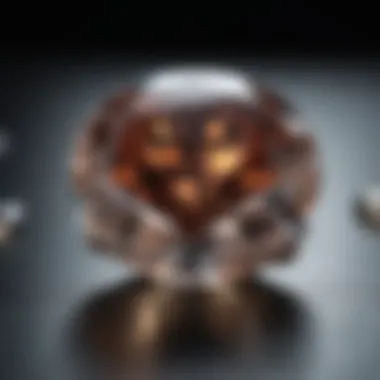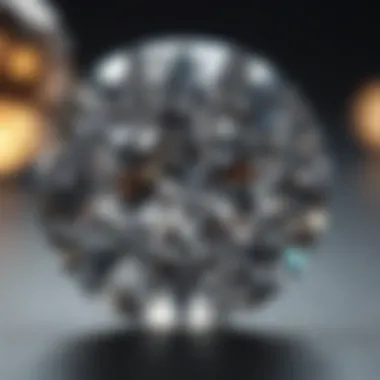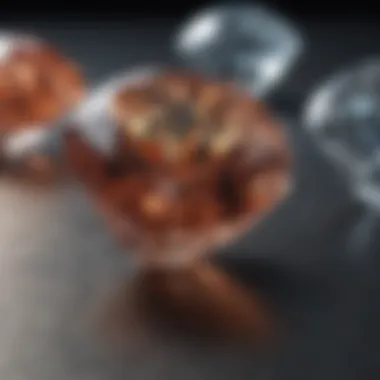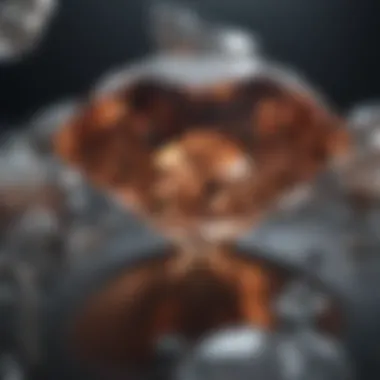Unveiling the Intricate Diamond Supply Chain: From Mine to Market


Overview of Gemstones and Minerals
Gemstones and minerals have held a significant place in human history and culture for centuries. The use of these precious stones dates back to ancient times, where they were valued for their beauty, rarity, and perceived mystical properties. Gemstones play a crucial role in various cultures and societies, symbolizing wealth, power, and even spiritual significance.
Gemstone Formation and Properties
The formation of gemstones is a complex and fascinating process that spans millions of years. These valuable stones are created deep within the earth's crust under intense heat and pressure. The journey from raw mineral to exquisite gem involves intricate geological processes that result in the formation of crystals with unique properties. Gemstones are characterized by distinct properties such as color, hardness, and luster. These factors play a vital role in identifying and evaluating gemstones, as they determine their quality and value in the market.
Types of Gemstones
Gemstones are classified into two broad categories: precious and semi-precious. Precious gemstones like diamonds, rubies, sapphires, and emeralds are highly valuable and rare, commanding high prices in the market. Semi-precious gemstones, on the other hand, include stones like amethyst, topaz, and turquoise, which are more readily available and affordable.
Identifying and Evaluating Gemstones
Several factors impact the value of gemstones, including color intensity, clarity, cut quality, and carat weight. Gemologists use advanced techniques such as spectroscopy and microscopy to identify and assess the quality of gemstones accurately. Evaluating gemstone quality requires expert knowledge and experience to differentiate between various grades and determine the market value of the stone.
Caring for Gemstones
Proper care and maintenance are essential to preserve the beauty and longevity of gemstones. Cleaning and storing gemstones correctly can prevent damage and oxidation, ensuring their brilliance and luster are maintained. Avoiding common mistakes like exposure to harsh chemicals or sudden temperature changes can safeguard your gemstone collection for generations to come. Understanding the specific care requirements of each gem type is crucial for preserving their natural beauty and value.
Introduction
In the vast tapestry of the diamond industry, the art of acquiring these coveted gemstones is a meticulous dance between nature's marvels and human ingenuity. This article embarks on a riveting exploration of the diamond supply chain, delving into the depths of where jewelers procure their precious diamonds. Brace yourself for an insightful journey that unveils the hidden intricacies of diamond sourcing, cutting, and distribution that culminate in these radiant gems adorning the shelves of exclusive jewelry boutiques.
The significance of comprehending the diamond supply chain in this article lies in unraveling the enigmatic pathway that diamonds traverse from their humble origins deep within the earth to becoming exquisite adornments cherished by many. By immersing ourselves in the nuances of diamond acquisition, we gain a profound appreciation for the artistry, precision, and craftsmanship that underpin the entire process. Understanding where jewelers buy their diamonds sheds light on not just the commercial aspects but also the geological, technological, and ethical dimensions that shape the industry.
From the intricacies of diamond mining, through the labyrinthine paths of distribution, to the final allure of diamonds elegantly showcased in jewelry stores, each phase in the supply chain narrates a story of resilience, innovation, and finesse. By unraveling this narrative thread, we uncover a realm where rarity meets demand, where tradition intersects with modernity, and where ethical principles guide every facet of the glittering trade. This article serves as a beacon, illuminating the multifaceted nature of the diamond supply chain and inviting readers to explore a world where nature's brilliance meets human artistry in perfect harmony.
Understanding the Diamond Industry
In the realm of the diamond industry, a profound understanding is paramount to navigating the complexities of the supply chain. Understanding the Diamond Industry equips stakeholders with the knowledge essential for discerning quality, value, and ethical sourcing. By delving into the intricacies of diamond mining, cutting, and certification, one gains insight into the meticulous craftsmanship and precision required in each phase.
Diamond Mining: Unearthing Precious Gems


Exploration and Discovery of Diamond Deposits
Exploration and Discovery of Diamond Deposits is a crucial facet of the diamond industry as it lays the foundation for resource identification. The meticulous process involves geophysical surveys, sampling, and feasibility studies to uncover potential diamond reserves. This stage determines the viability of mining operations and influences the overall supply chain's efficiency.
Open-Pit Mining vs. Underground Mining Techniques
Exploring the choice between Open-Pit Mining and Underground Mining Techniques unveils varying approaches to retrieving diamonds from the earth. Open-pit mining offers easier access to shallow deposits, while underground mining delves deeper for ores. Understanding the differences aids in optimizing resource extraction based on geographical and geological considerations.
Sustainable Mining Practices
Embracing Sustainable Mining Practices is imperative to ensure the longevity of diamond reserves and minimize environmental impact. Implementing eco-friendly techniques, reclamation efforts, and community engagement enhance the industry's social responsibility and sustainability. Striking a balance between resource exploitation and conservation is pivotal for a thriving diamond ecosystem.
Diamond Cutting and Polishing: Crafting Brilliance
The art of Diamond Cutting and Polishing is where rough diamonds metamorphose into exquisite jewels of brilliance and allure. The precision and expertise involved in faceting and shaping diamonds determine the stone's fire, scintillation, and overall visual appeal. Leveraging advanced cutting techniques and technology elevates the craftsmanship to create masterpieces that captivate the beholder.
Art of Faceting and Shaping Diamonds
Mastering the Art of Faceting and Shaping Diamonds requires honed skills and artistic vision to unleash the stone's inherent beauty. The intricacies of facet placement, angles, and symmetry are meticulously executed to maximize light reflection and dispersion, enhancing the diamond's luminosity and brilliance.
Precision Cutting Techniques
Employing Precision Cutting Techniques is paramount in achieving ideal proportions and symmetry to optimize a diamond's optical performance. Advanced tools and equipment enable artisans to execute intricate cuts with micron-level precision, enhancing light reflection and refraction for maximum sparkle and scintillation.
Role of Technology in Diamond Cutting
Technology plays a pivotal role in revolutionizing diamond cutting, allowing for enhanced precision, efficiency, and creativity in design. From laser cutting to computer-aided design (CAD) technologies, the integration of innovations improves the speed and accuracy of the cutting process, leading to the creation of unique and flawless diamond facets.
The Diamond Supply Chain
The Diamond Supply Chain plays a crucial role in the intricate process of how jewelers acquire diamonds. It serves as the backbone of the diamond industry, facilitating the journey of diamonds from mining to distribution. Understanding the Diamond Supply Chain is imperative for all stakeholders involved in the diamond trade, ensuring ethical practices, quality control, and sustainability. By exploring the various elements within the Diamond Supply Chain, such as wholesalers, dealers, manufacturers, and retailers, we gain insights into the complex network that culminates in the exquisite diamond jewelry adorning display cases.
Diamond Wholesalers: Connecting Miners to Jewelers


Role of Wholesalers in Diamond Distribution
The Role of Wholesalers in Diamond Distribution is pivotal in bridging the gap between diamond miners and jewelry retailers. Wholesalers act as intermediaries, sourcing diamonds directly from mining companies and supplying them to manufacturers and retailers. Their expertise lies in efficient sourcing, aggregation, and quality assessment, ensuring a steady supply of diamonds to meet market demands. This centralized distribution channel simplifies the procurement process for jewelers, offering a wide range of diamonds at competitive prices.
Diamond Aggregators and Sorting Facilities
Diamond Aggregators and Sorting Facilities streamline the process of categorizing and valuing rough diamonds sourced from different mines. These facilities utilize advanced technology and expertise to assess the quality, size, and value of rough diamonds before distribution. By centralizing the sorting process, diamond aggregators ensure consistency in diamond quality and pricing, enhancing transparency and trust within the supply chain.
Negotiating Diamond Prices
Negotiating Diamond Prices is a key aspect of the diamond trade, involving intricate price discussions between wholesalers, manufacturers, and retailers. Wholesalers play a significant role in negotiating favorable prices with miners, based on factors such as diamond quality, carat weight, and market trends. These negotiations impact the final retail prices of diamond jewelry, influencing consumer preferences and market dynamics.
Diamond Dealers: Bridge Between Wholesalers and Retailers
Diamond Trading Centers and Exchanges
Diamond Trading Centers and Exchanges serve as hubs where wholesalers, manufacturers, and retailers converge to trade diamonds. These centers facilitate transactions, price negotiations, and market research, providing a platform for industry players to interact and negotiate deals. By tracking market trends and demand-supply dynamics, diamond dealers play a crucial role in determining diamond prices and facilitating smooth transactions.
Factors Influencing Dealer Prices
Various factors influence dealer prices, including diamond quality, market demand, economic conditions, and consumer preferences. Diamond dealers must stay informed about these dynamic factors to make informed pricing decisions and capitalize on market opportunities. By understanding the intricacies of pricing mechanisms, dealers can optimize their revenue streams and maintain competitiveness in the diamond market.
Understanding Diamond Market Trends
A comprehensive understanding of Diamond Market Trends is essential for dealers to adapt to evolving consumer preferences and industry dynamics. By analyzing market data, consumer behavior, and competitor strategies, dealers can position themselves strategically in the market. Understanding emerging trends such as ethical sourcing, sustainable practices, and technological advancements enables dealers to leverage opportunities and stay ahead in the competitive diamond industry.
Emerging Trends and Challenges
Emerging trends and challenges play a crucial role in shaping the diamond industry's landscape. These factors drive innovation, sustainability, and ethical practices within the supply chain. Jewelers and consumers are increasingly aware of the importance of ethical sourcing and sustainability in diamond acquisition. The industry is witnessing a shift towards more responsible sourcing practices to address concerns about environmental impact and ethical considerations. In addition, the emergence of lab-grown diamonds is disrupting traditional market dynamics, offering unique advantages and posing challenges that require adaptation and industry-wide responses.
Ethical Sourcing and Sustainability
Conflict-Free Diamonds


Conflict-free diamonds are diamonds that are sourced without any involvement in conflicts or unethical practices. The significance of conflict-free diamonds lies in their ethical sourcing, ensuring that the diamonds do not contribute to funding armed conflicts or human rights abuses. Jewelers and consumers opt for conflict-free diamonds to support ethical practices and promote transparency in the supply chain. The key characteristic of conflict-free diamonds is their certification, indicating their origin from conflict-free zones. This choice enhances consumer trust and aligns with ethical values, making conflict-free diamonds a preferred option in the industry.
Environmental Impact of Diamond Mining
The environmental impact of diamond mining refers to the ecological consequences of extracting diamonds from the earth. This aspect is crucial as mining activities can lead to deforestation, soil erosion, and habitat destruction if not managed sustainably. Recognizing the importance of environmental conservation, industry stakeholders are exploring eco-friendly mining practices to minimize adverse effects on the environment. Sustainable mining techniques and reclamation efforts are employed to mitigate the environmental footprint of diamond mining. Despite challenges, efforts to reduce the environmental impact of diamond mining are essential for promoting long-term sustainability in the industry.
Supporting Ethical Practices in the Industry
Supporting ethical practices in the diamond industry involves promoting fair labor conditions, community development, and responsible sourcing of diamonds. Ethical practices ensure that the entire supply chain upholds social and environmental standards, benefiting miners, workers, and local communities. By integrating ethical considerations into their operations, companies contribute to a more sustainable and transparent industry. Consumer demand for ethically sourced diamonds drives businesses to adopt ethical practices, reinforcing the importance of accountability and integrity in the diamond trade.
Lab-Grown Diamonds: Disrupting the Market
Lab-grown diamonds present a disruptive innovation in the diamond market, offering eco-friendly, cost-effective alternatives to natural diamonds. The advantages of lab-grown diamonds include reduced environmental impact, traceability, and consistency in quality. Consumers are increasingly accepting lab-grown diamonds due to their sustainable production methods and guaranteed origin. However, challenges such as market perception, differentiation from natural diamonds, and regulatory frameworks pose hurdles for the lab-grown diamond industry. Overcoming these challenges requires strategic marketing, educating consumers, and ensuring ethical production standards to establish a prominent position in the market.
Advantages of Lab-Grown Diamonds
The advantages of lab-grown diamonds lie in their sustainable production methods and ethical considerations. These diamonds are created in controlled environments using advanced technology, reducing the environmental footprint associated with traditional diamond mining. Additionally, lab-grown diamonds offer traceability, allowing consumers to verify their origin and authenticity. The key characteristic of lab-grown diamonds is their identical composition to natural diamonds, providing a conflict-free and environmentally conscious alternative for buyers.
Consumer Perception and Acceptance
Consumer perception and acceptance play a pivotal role in the market adoption of lab-grown diamonds. Educating consumers about the benefits of lab-grown diamonds is essential to dispel misconceptions and build trust in the product. Factors such as price affordability, eco-friendliness, and quality assurance influence consumer preferences towards lab-grown diamonds. Transparency in marketing and highlighting the advantages of lab-grown diamonds are critical to creating a positive perception and increasing consumer acceptance of these sustainable gemstones.
Challenges Faced by Lab-Grown Diamond Industry
The lab-grown diamond industry faces challenges related to market differentiation, consumer awareness, and regulatory frameworks. Distinguishing lab-grown diamonds from natural diamonds in the market requires clear branding and communication strategies. Educating consumers about the unique attributes of lab-grown diamonds and addressing concerns about their value and authenticity are ongoing challenges. Regulatory standards for labeling and certification of lab-grown diamonds are evolving, necessitating compliance and industry-wide standards to ensure consumer trust and confidence in these innovative products.
Impact of Technology on Diamond Trade
Technological advancements have revolutionized the diamond trade, driving efficiency, transparency, and consumer engagement. Blockchain technology is utilized to enhance traceability and authentication in the diamond supply chain, reducing the risk of fraud and unethical practices. Virtual diamond marketplaces provide a digital platform for buying and selling diamonds, expanding market reach and accessibility. By leveraging technology, businesses can enhance the customer experience through personalized services, virtual consultations, and augmented reality platforms that allow customers to visualize and customize their diamond purchases.
Blockchain in Diamond Traceability
Blockchain technology enables secure, decentralized record-keeping of diamond transactions, enhancing transparency and traceability in the supply chain. Each diamond is assigned a unique digital identity stored on a blockchain ledger, offering immutable and verifiable information about its origin and history. The key characteristic of blockchain in diamond traceability is its ability to prevent diamond tampering, fraud, and counterfeit practices. By leveraging blockchain technology, stakeholders in the diamond industry can establish trust, streamline certification processes, and combat the circulation of conflict diamonds.
Virtual Diamond Marketplaces
Virtual diamond marketplaces are online platforms that connect buyers and sellers in the diamond industry, enabling virtual transactions and digital showcases of diamond inventory. These platforms offer convenience, accessibility, and a global reach for diamond trading, expanding market opportunities and facilitating streamlined sales processes. The key characteristic of virtual diamond marketplaces is their virtual inventory management and secure payment systems, allowing customers to browse and purchase diamonds remotely. Virtual marketplaces revolutionize the traditional diamond trade by providing a digital ecosystem for diamond transactions and promoting efficiency in the purchasing journey.
Enhancing Customer Experience with Technology
Enhancing customer experience with technology involves leveraging digital tools and interactive platforms to engage customers and deliver personalized services. Virtual try-on experiences, 3D modeling, and virtual consultations enable customers to visualize and customize their selected diamonds before making a purchase. The key characteristic of technology in enhancing customer experience is its ability to create immersive and interactive interactions, fostering customer loyalty and satisfaction. By embracing technological innovations, jewelers can offer a differentiated and personalized experience to customers, driving sales and cultivating long-term relationships in the competitive diamond market.







